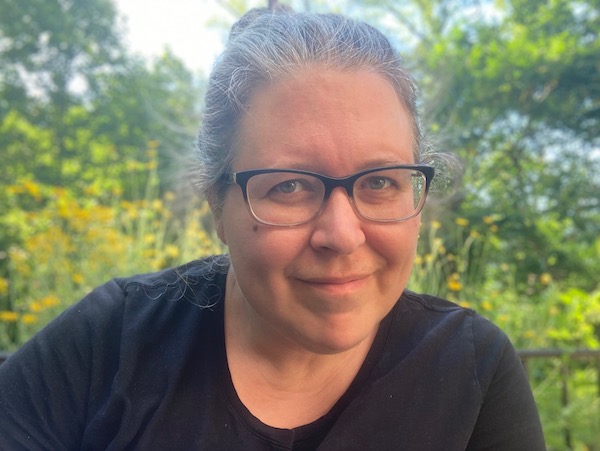A deep dive into botanicals with Gail of Hudson Highlands Co.
Posted by Cindy on Aug 9th 2022
 Gail Cunningham O’Donnell dyes yarn using botanicals, creating gorgeous semi-solid and variegated colorways, right here in the Hudson Valley. Gail is also a weaver, knitter, textile lover, and artist. You may have seen her working here at The Endless Skein.
Gail Cunningham O’Donnell dyes yarn using botanicals, creating gorgeous semi-solid and variegated colorways, right here in the Hudson Valley. Gail is also a weaver, knitter, textile lover, and artist. You may have seen her working here at The Endless Skein.
Gail's Hudson Highlands Co. yarn is available at The Endless Skein, both online and in-store.
Gail teaches popular Natural Dyeing Workshops -- read on for more details about her upcoming classes!
We had so many questions for Gail, which she was gracious enough to answer!
How did you become interested in working with fiber and botanical dyes?
I grew up around fibers. My mother was always knitting and sewing clothes or things for the house, I had one grandmother who made quilts, the other taught me how to crochet. I fell in love with fibers at a pretty young age and therefore spent a lot of time untangling thread, yarn and embroidery floss. I became interested in natural dyeing as a Fiber major in college. At the time it wasn’t a common practice and it was difficult to find information and supplies. It wasn’t taught at my school, except that we had access to a 50-gallon indigo vat. That was my first experience with the magic of indigo and I was amazed.

It’s not easy to get such vivid colors using natural dyes. How did you discover the secrets?
It took about 15 years before I seriously got back into indigo and natural dyeing, looking back I think it was mostly because I was intimidated. It is easy to get overwhelmed by all the steps and information. I finally made the time and space and I just dove in. I have learned everything (with the exception of my introduction to indigo) by reading, researching, experimenting and failing. There have been a lot of failures along the way, and they often turn out to be really informative and interesting.
When you are developing new colorways, do you try to get a particular color, or do you experiment to see what colors you end up with (or both)?
Before I began dyeing wool in production, I just explored and played and took copious notes, so once I was ready to dive into production I had a pretty good idea of what colors I wanted and what I could get. Now new color ways tend to come out of happy accidents. I shoot to get a certain color and when I end up with something else I backtrack into my notes, see if I can figure out what happened and then see if I can reproduce it. It’s always an experiment, no matter how sure I am of what I’m doing.
What are your go-to botanicals? Do you tend to stick with the same plants, or do you add new ones into the mix from time to time?
My workhorse botanical dyes are indigo, madder (red), and weld or fustic (yellows). These are very lightfast and wash fast dyes. I also use iron in small amounts to shift colors and I use a couple other plants to get some colors that I can’t get with those five.

What parts of plants are typically used for dyeing?
It really depends on the plant. Indigo you typically extract the pigment from the whole plant before it goes to seed. With madder you only use the root, and only after it has been growing for 2-5 years. Fustic is from the heartwood of a tree that’s in the Mulberry family. Marigolds and Dyer’s Chamomile are good examples of plants that give dye just from the flower head.
Are fungi ever used for dyeing?
Yes! People use fungi, lichen, trees, shells, bugs, metals, salts, food waste… It’s amazing the amount of research, exploration, and experimentation that has been done over millennia just for the sake of putting color in cloth!! I am forever fascinated by the history of natural dyes and textiles and how they have impacted us as humans.
Do some of the botanicals you use come from your own garden? Are others sourced locally, or do not all of the plants you use grow in this climate?
I think this is an important question. I have found that the general assumption is that I source all my dyes from my own garden, but that isn’t the case for me. I have a dye garden that I love and learn a great deal from year after year. I think it’s important to understand the plants I work with the best I can, and to understand the full process of using these plants to create dyes, but my garden can’t sustain Hudson Highlands as a business. So I use plant extracts. It saves a great deal of time in an already very long process, and it also supports a supply chain I believe in. Responsibly using sustainable natural dyes has the potential to reduce the impact we have on our planet, but the only way for them to make that impact is to move them out of our home gardens and onto a more industrial scale (because let’s be real, we are never going back to a time when everyone spun, wove and dyed their own garments). So, when a really big brand can find a way to create a naturally dyed line of clothing I feel we are moving in the right direction. The conversation isn’t about my garden, it’s about sustainable agriculture, about slow fashion (something knitters know all about!), and about how to use our resources wisely. There is a growing list of really great companies, large and small, and people out there working on making this happen.

What’s the biggest challenge you’ve encountered with dyeing yarn naturally?
Well, honestly, I have a tendency to be a perfectionist, and working with wool and natural dyes really pushes me to be more relaxed and open to what happens.
What has surprised you in your work with fiber and botanical dyes? Has the work taken you places you didn’t expect to go?
When I began I didn’t realize just how scientific and mathematical the work would be! I also didn’t realize how interested I would become in wool. I’m definitely still learning so much. I tour fiber mills, talk with sheep farmers, watch shearing videos, and just try and soak up as much as I can about wool. I didn’t see that coming when I started. I started because I was interested in color and the dye process, and now I daydream about having a small flock of sheep and taking chemistry classes.

What classes and workshops have you taught? Do you have any coming up?
I’ve given a couple workshops in town on dyeing cotton fabric with indigo using a clay paste resist to create designs. Working with indigo is great because it’s so immediate and magical. More recently I’ve been dreaming up some possibilities of a class where you would dye wool and learn to weave tapestry with it?? I’m not sure yet, but some things are definitely brewing.
2023 Update: Gail is teaching Natural Dyeing Workshops at The Endless Skein! Keep reading for links to her upcoming workshops.
You learned to knit recently, but you’ve been picking up skills at a rapid pace. Do you have a favorite technique? What’s on your needles right now?
 I can’t believe I never learned to knit before now! At first I was fascinated by cables, and now I’m really obsessed with color work. I just love how graphic it is. I’m currently knitting Maya Gooding’s Waver Cowl. She designed it with Hudson Highlands yarn and I’m loving knitting it. It’s a beautiful design and I’m flattered she wanted to work with me!
I can’t believe I never learned to knit before now! At first I was fascinated by cables, and now I’m really obsessed with color work. I just love how graphic it is. I’m currently knitting Maya Gooding’s Waver Cowl. She designed it with Hudson Highlands yarn and I’m loving knitting it. It’s a beautiful design and I’m flattered she wanted to work with me!
What’s on the horizon for Hudson Highlands yarn, and/or your other projects?
I’m branching out into craft fairs this summer, and Hudson Highlands will have its very first booth at the Riverside Craft Fair at the Garrison Art Center this August 20-21, 2022. I’m really excited to be a part of their fair. We are so lucky in the Hudson Valley to have a community that is so supportive of the arts. Personally, I’m hoping to get more playtime with natural dyes and pigments. I’ve been learning how to make inks, I found a good recipe for natural pastels I’d like to try, I’ve been experimenting with Eco Printing, and I’d like to see where that all takes me.
Be sure to follow Gail on Instagram @hudsonhighlands!
The Endless Skein carries Gail's Hudson Highlands Co. yarn in both sport-weight and DK-weight. Check out her yarn online and in our brick-and-mortar store!
Gail is teaching several upcoming workshops at The Endless Skein:
- Natural Dye Workshop I -- dyeing yarn using kitchen scraps -- Sunday, April 23, 2023 -- This workshop is now FULL.
- Rhinebeck Sweater Dye Workshop -- Saturday, June 17, 2023 -- This workshop is now FULL.
- Natural Dye Workshop II -- Bundle Dyeing -- Saturday, August 19, 2023. Space is very limited!

